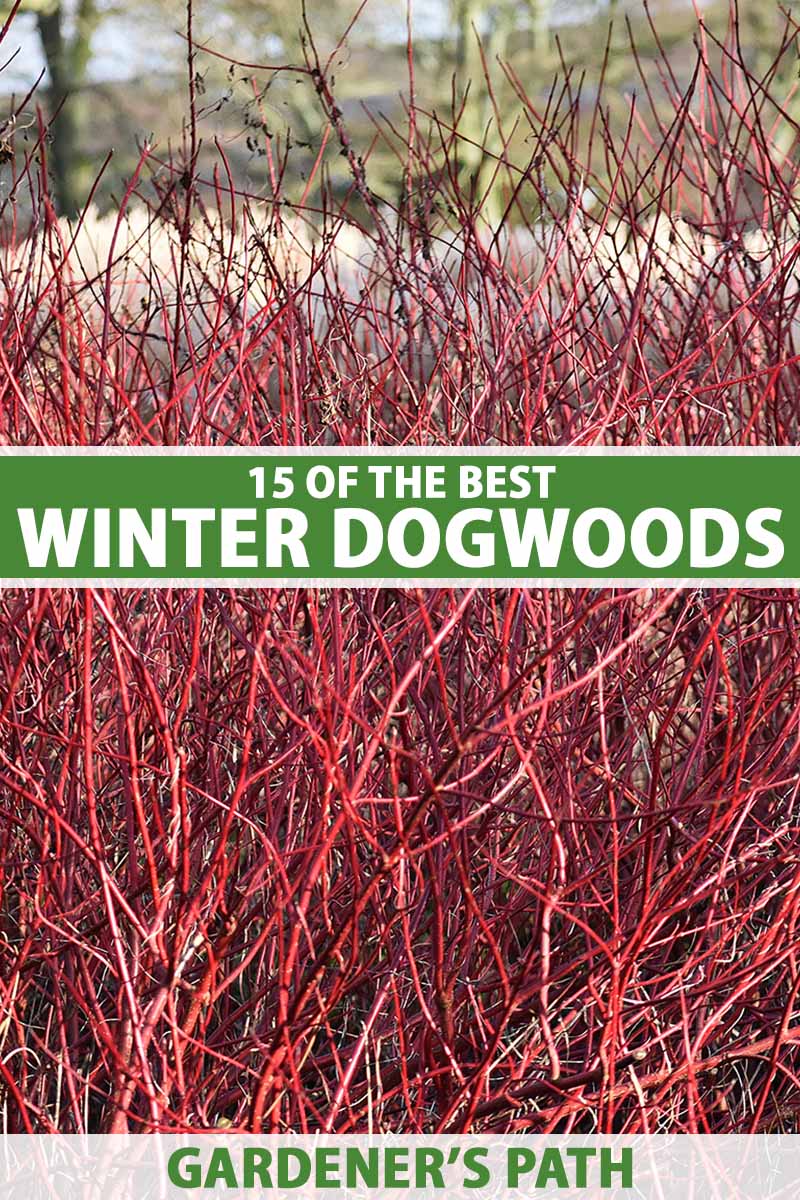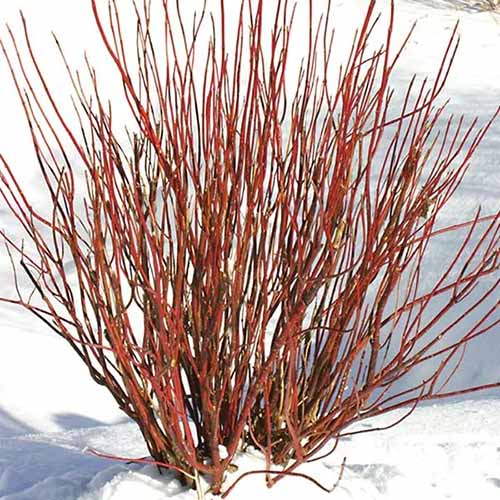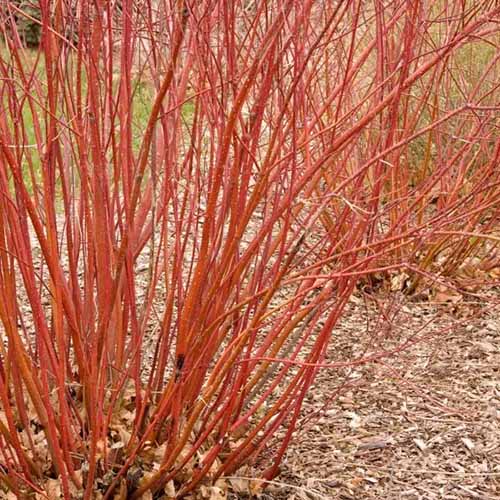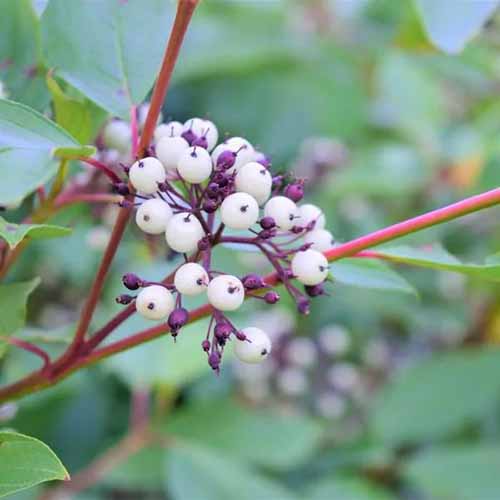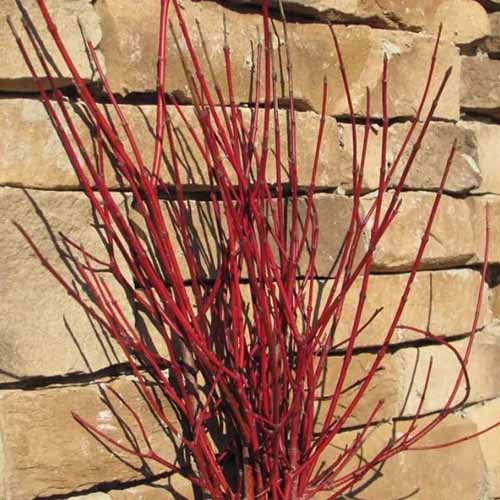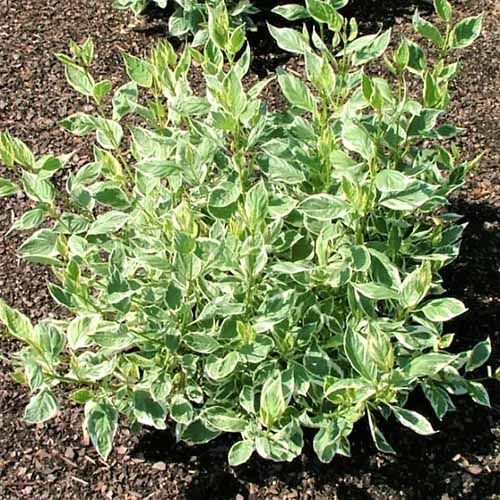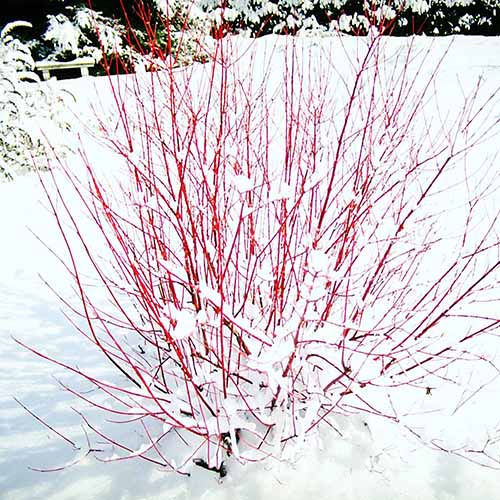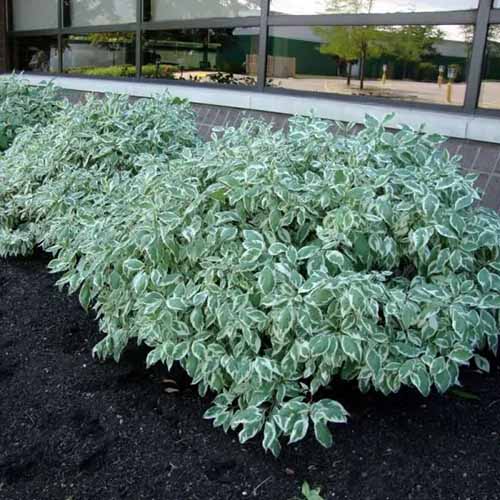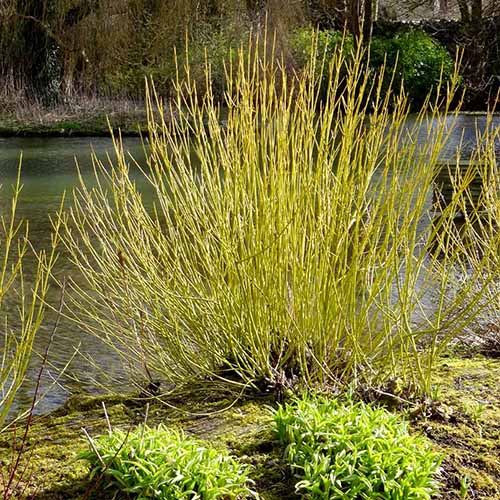We work so hard to make our landscapes look incredible during the growing season. Why neglect them in the winter?
Dogwoods can provide an easy way to add a little color and shape to an otherwise bland space.
If you’ve ever stared out of a window at a garden that once was a riot of flowers and foliage, only to be miserably greeted by bare ground and dead plant material in the middle of February, you know how important a little colorful interest can be.

We link to vendors to help you find relevant products. If you buy from one of our links, we may earn a commission.
And dogwoods don’t just add color to the garden. You can collect the stems and use them in floral arrangements indoors to liven up your interiors, too.
That would be enough to recommend them, in my book. But as an added bonus, they can be exceptionally beautiful during the warmer months as well.
In other words, they are truly the type of plants that offer four seasons of excitement in the landscape.
We’ll look at 15 exceptional options in more detail. Here’s the lineup:
15 Dogwoods to Add Winter Color
All dogwoods perform better if you trim off some of the older stems to make room for the new growth, which tends to have brighter colors.
They also have the brightest hues when grown in full sun even though most can tolerate some shade.
You can learn more about growing dogwoods in our guide.
Without further ado, let’s start with a fiery option:
1. Arctic Fire
In Zones 3 to 7, C. sericea Arctic Fire® or ‘Farrow’ lives up to its name, with fiery red twigs on a dwarf plant that stays under four feet tall and wide.
Unlike the species, it doesn’t sucker, so you aren’t going to have to fight to keep it under control.
Dark green leaves pop out in the spring, followed by white flowers that give way to white berries. Use it as an informal hedge or display it in a large container to highlight the winter color.
You can bring one home from Nature Hills Nursery as a three- to four-foot bare root or a live plant in a #3 container.
Learn more about growing Arctic Fire and other red twig dogwoods in our guide.
2. Arctic Sun
I’m particularly fond of the stems on C. sanguinea ‘Cato,’ also known as Arctic Sun®.
Released in 2009 and hardy in Zones 3 to 9, the stems have a beautiful ombre of crimson at the tips, gradually transitioning to yellow at the base.
It looks like a warm sunset in the middle of the most colorless time of year.
The green leaves turn golden yellow in the fall, with white drupes as an accent.
In the spring, star-shaped white flowers – actually leaf bracts – appear in clusters all over the dwarf four-foot-tall and wide shrub.
Visit Nature Hills Nursery for a plant (or two) of your own.
3. Bailey
There are lots of red-stemmed dogwoods out there, but few can rival the fiery scarlet hue of C. sericea ‘Bailey.’
Even without its medium green leaves, it makes a massive statement in the winter, with the stems stretching 10 feet tall and wide, or even a bit wider.
In the spring, white flower clusters decorate the ends of the branches, followed by bluish berries.
The autumn leaves take on a reddish-purple hue, but honestly, you’ll be rooting for them to fall so you can enjoy the bare stems.
Nature Hills Nursery has this bold bush available in three- to four-foot bare roots, or live plants in #3 or #5 containers. Grow it in Zones 3 to 9.
4. Bud’s Yellow
If you have a large area that needs some brightening up, get your hands on ‘Bud’s Yellow.’
This C. sericea cultivar will spread up to eight feet tall and wide, and it will send out suckers to start new plants.
Perfect for those slopes or streambanks that need some support and some color as well, the bright yellow stems are so vibrant they almost look neon.
This variety is also disease-resistant, so you don’t have to worry about fungal issues marring the medium green foliage.
Enjoy white flowers in the spring and snowy berries in the fall, accompanied by cheery yellow foliage.
Bring home a three- to four-foot bare-root or a live plant in a #3 container from Nature Hills Nursery for growing in Zones 2 to 8.
5. Cardinal
When this plant was developed at the University of Minnesota Landscape Arboretum in Chanhassen, Minnesota, in 1986, they picked an excellent name.
The cardinal red stems on this 10-foot-tall and wide shrub offer a vibrant contrast to winter gray and snow.
The fragrant white flowers are followed by cream-colored fruits in the fall, when the foliage turns deep purple. It’s a fabulous option for growing in Zones 3 to 8.
Visit Nature Hills to pick up a four- to five-foot bare-root or a live plant in a #3 container.
6. Cayenne
Bringing a bit of spice to the humdrum dormant landscape, C. amomum ‘Cayenne’ stands apart from some other dogwoods because its bright red stems will hold their color even in warmer regions.
With green leaves that turn orange-red in the fall, highlighting the pale blue berries, it makes a suitable addition whether you want to mitigate erosion or just add some color to the garden.
This shrub is both canker- and Japanese beetle-resistant. It grows rapidly to about six feet tall and 12 feet wide.
Want to add some spice to your life? Head to Nature Hills Nursery for some ‘Cayenne.’ It grows well in Zones 4 to 9.
7. Creme de Mint
A variegated cultivar of Tartarian dogwood, Creme de Mint™ (C. alba ‘Crmizam’) has medium green leaves with cream edges. In the fall, the foliage takes on a pinkish-red hue.
Once the leaves fall to the ground, bright chartreuse stems add some color to the landscape.
The white spring flowers will attract bees and butterflies, and the fall berries in bluish-white will feed the birds that visit your yard.
And this shrub won’t become overbearing, staying at a petite five feet tall and wide. It won’t sucker and spread where you don’t want it either.
Add a hint of mint to your garden by visiting Nature Hills Nursery for a live plant of your own, for growing in Zones 3 to 8.
8. Ivory Halo
Beautiful C. alba ‘Baihalo,’ known commonly as Ivory Halo®, is a delight from spring through fall with its dark-green foliage edged in ivory white, along with yellowish spring flowers and bluish-white fruits in the fall.
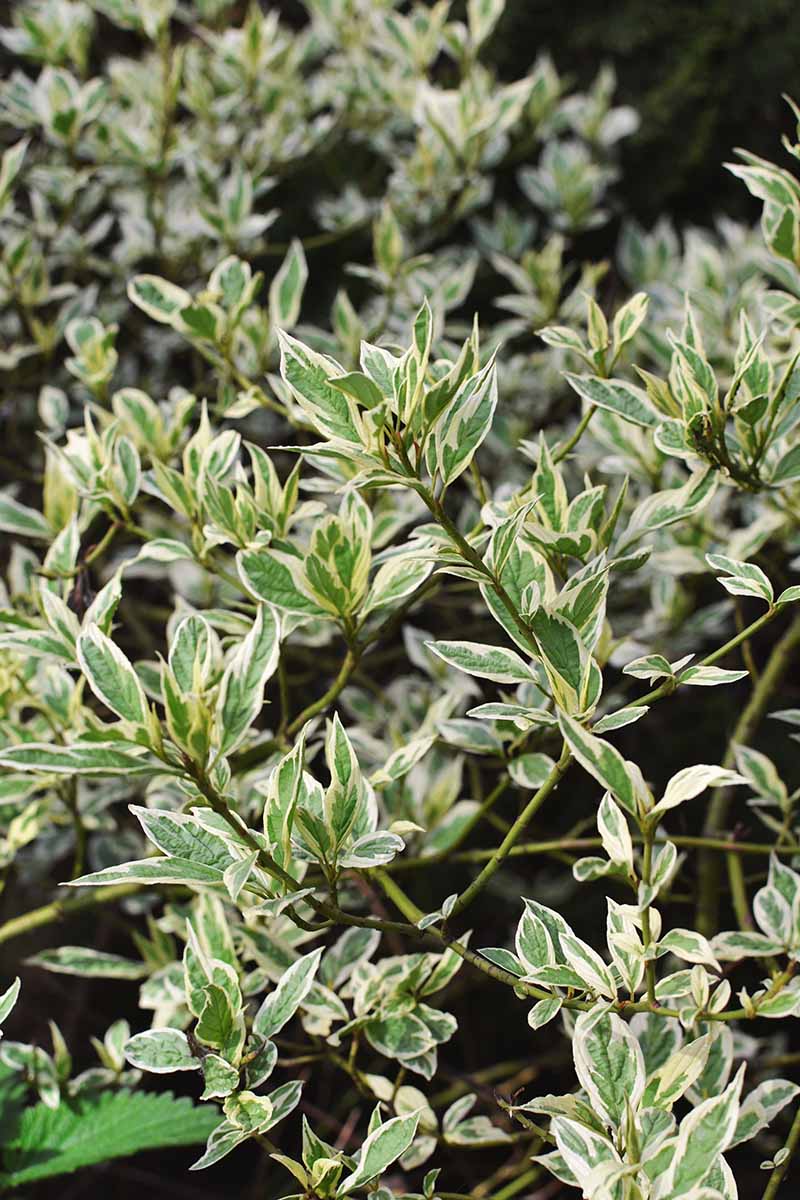
But as beautiful as the foliage is, you’ll be counting down the days until those leaves turn purple-red in the fall and drop to the ground so you can enjoy the vibrant red branches.
Just picture how much they will stand out against the winter snow in Zones 3 to 7.
This dwarf shrub stays at about six feet tall and wide at maturity, and while it will spread via suckers, it isn’t as prolific as some of its relatives.
9. Kesselringii
In garden design, you always want a few elements of dark black or brown to anchor an area. A Tartarian dogwood cultivar, C. alba ‘Kesselringii’ is just the thing for the job.
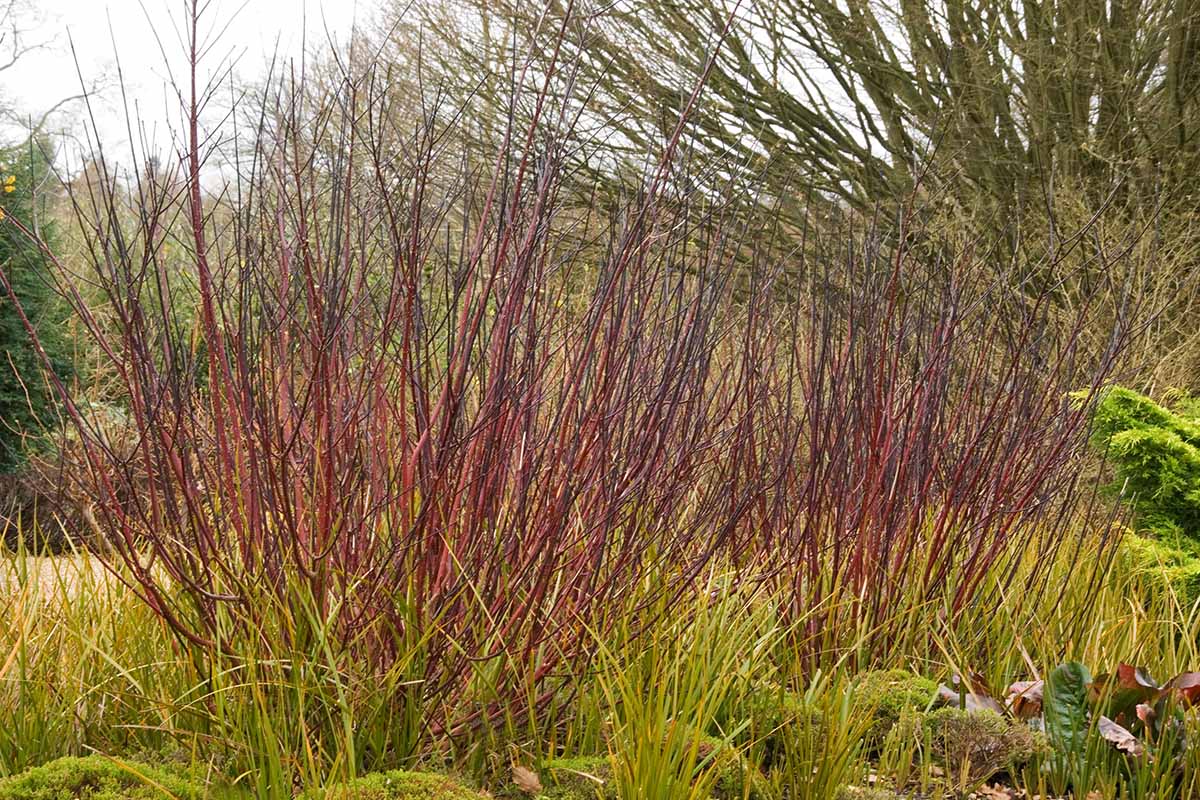
In the spring, summer, and fall, the dark red stems act as a dramatic focal point underneath the medium-green leaves.
But it’s even more dramatic when the stems turn dark purple in the winter, acting as a visual anchor whether your landscape tends towards greens and browns or snowy white.
This fast-growing shrub will reach six feet tall and wide within the first year after planting, and it’s decorated in yellowish blossoms in the spring and sometimes into the summer, as well.
In the fall, the foliage transitions to a beautiful burgundy hue.
This all-season pleaser is suited to a wide range of climates in Zones 2 to 7.
10. Pacific Dogwood
Okay, hear me out. Pacific dogwood (C. nuttalli) doesn’t have the bright yellow or red stems that make other species so popular in the winter landscape.
But don’t pass over this option if you live in Zones 7 to 9, where you might not have long periods of snow but you still crave some winter interest.
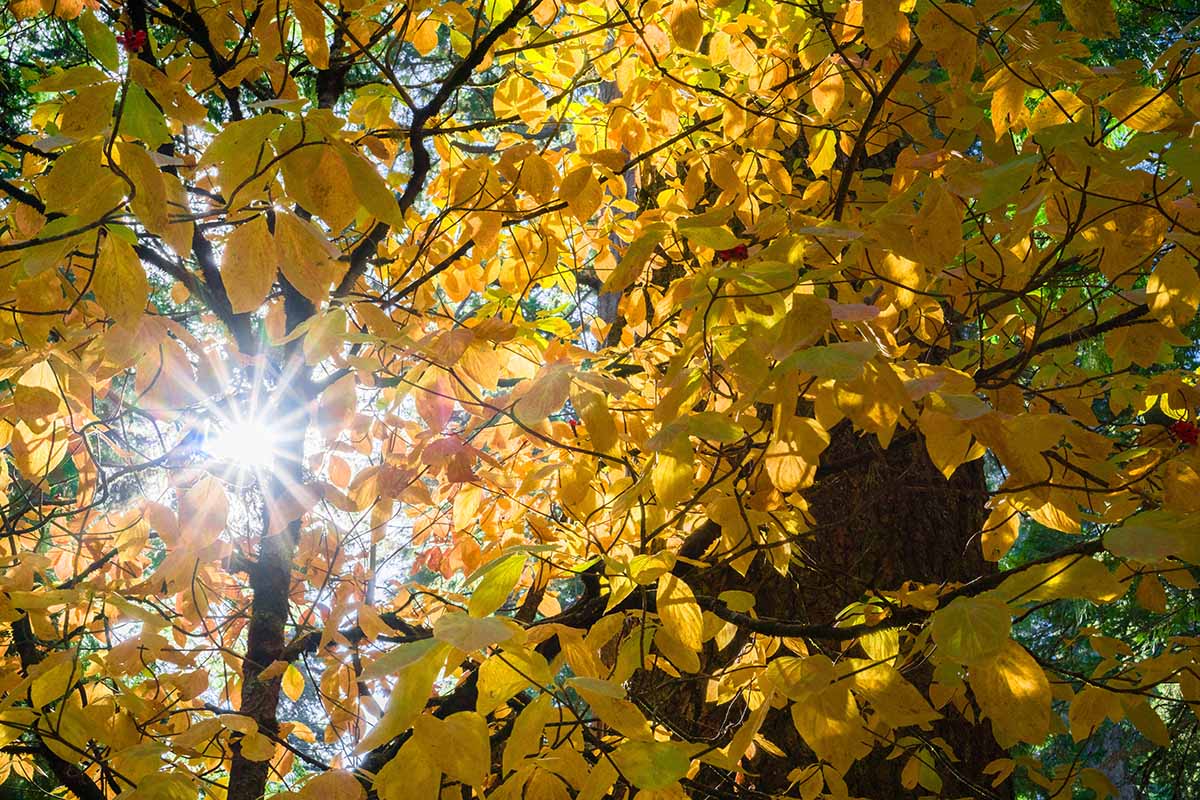
The white or pinkish-colored flowers are much showier than anything on this list, coming in at nearly three inches in diameter.
They appear once in the spring and again in the early fall, followed by orange or pink drupes that persist on the tree well into the winter until the wildlife devours them.
That’s part of what makes this 20- to 40-foot-tall tree an excellent display option in the dormant season.
Combined with the reddish bark and branches that take on a gracefully arching habit, it makes an architectural statement rather than a more colorful one.
11. Prairie Fire
Planted en masse, the aptly named C. alba ‘Prairie Fire’ looks like a field of flaming eight-foot-tall and wide shrubs highlighted against the winter snow.
But what makes it particularly special isn’t just the bright red winter twigs or the beautiful cream flowers, followed by white berries.
The bright golden and red fall foliage also sets it apart from many other dogwoods, which tend to be a little lackluster in the autumn.
In the spring, it’s equally attractive with its golden-yellow foliage. Grow it in Zones 2 to 7.
12. Red Osier
C. sericea adapts to climates in just about every part of the US except the warmer areas of Florida, Texas, California, and Arizona.
It can be grown in Zones 2 to 8, and is native to southern Canada, and the northern and western US.
This shrub will grow up to 12 feet tall and 14 feet wide, spreading via suckers.
While it’s hard to beat the bright red winter color, it’s nothing to sneeze at during the rest of the year.
The creamy white blossoms are long-lasting and gradually give way to clusters of white berries. The silky, medium-green leaves change to hues of red varying from rust to burgundy.
While these dogwoods can tolerate some shade, the bark color will be muted outside of full sun.
Fast Growing Trees has this beloved species available in quart, two-gallon, or three-gallon pots, in single or four-pack quantities.
13. Tartarian
C. alba is commonly known as Tartarian or white dogwood. It’s native to Siberia, northern China, and the Korean peninsula, where it grows as a small tree or large shrub.
Beloved for its red stems and vigorous growth habit, it can reach 10 feet tall and wide.

The oblong leaves are medium-green, with creamy-white blossoms and white berries. The fall foliage is bright red and orange.
Unlike the US native C. sericea, this species doesn’t tend to send out as many suckers – which may be a good or a bad thing, depending on your needs. It’s hardy in Zones 2 to 7.
14. Variegated Red Twig
A Tartarian dogwood cultivar, C. alba ‘Elegantissima’ is the definition of a year-round performer.
In the spring, the variegated medium green and creamy gold leaves emerge, along with white flowers. In the fall, white berries cover the shrub in clusters, highlighted against the orange, red, and gold foliage.
After everything drops to the ground, the rosy red stems are left behind to brighten up the garden in Zones 3 to 8.
Make sure you have the space for this plant, which grows 10 feet tall and wide, producing suckers that allow it to spread.
Make one yours by visiting Nature Hills Nursery.
15. Yellow Twig
Yellow twig dogwood (C. sericea ‘Flaviramea’) is appreciated in the garden for its dark green foliage, white flowers, and white fruit, but it’s the bare winter twigs that really stand out.
They have a bright golden-yellow hue that beams, contrasting with winter snow like a ray of sunshine.
When mature, it can grow to six feet tall and just a touch wider, and the plant will spread via suckers as much as you’ll let it.
That makes it perfect for areas that you want to fill in with color, or spots that could use some erosion control, like stream banks and slopes.
It’s not quite as winter-hardy as the species, growing in Zones 3 to 7.
Head to Fast Growing Trees to purchase individual plants or four-packs of two- to three-foot or three- to four-foot live shrubs.
Add Some Spice to the Winter Landscape
Whether you live somewhere snow-covered from December through March or you want to add some spice to a bland, gray garden, dogwoods fit the bill.
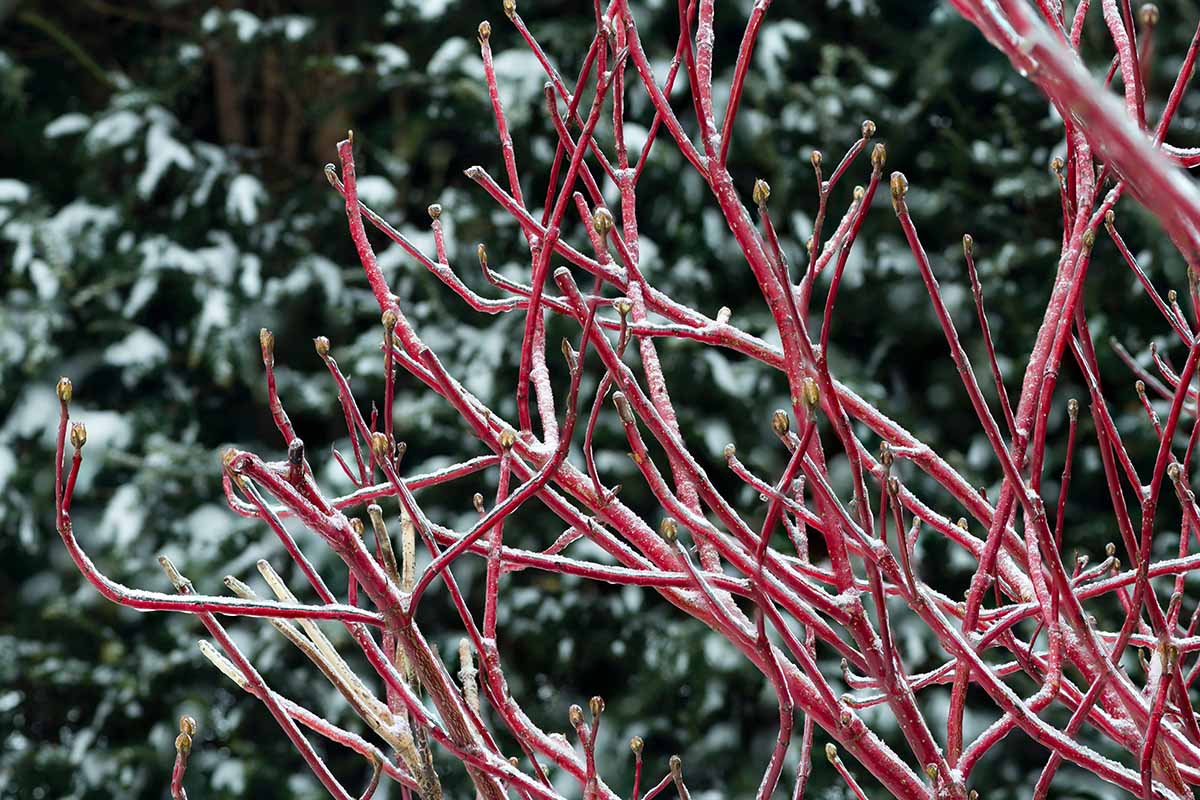
Which one of these sounds like the right one for your landscape? Let us know in the comments. And be sure to tell us if we missed one that you’re particularly fond of.
Now that you’ve sorted out the winter interest, you might be interested in learning more about dogwoods, like how to deal with problems, or choose a few others for your garden. If so, here are some guides worth checking out:
